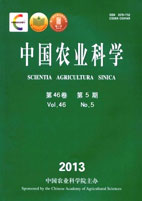-
Effects of Different Fertilizations on Organic Carbon and Nitrogen Contents in Water-Stable Aggregates and Microbial Biomass Content in Paddy Soil of Subtropical China
- CHEN Xiao-Fen, LI Zhong-Pei, LIU Ming, JIANG Chun-Yu
-
Scientia Agricultura Sinica. 2013, 46(5):
950-960.
doi:10.3864/j.issn.0578-1752.2013.05.010
-
 Abstract
(
1009 )
Abstract
(
1009 )
 PDF (673KB)
(
1393
)
PDF (673KB)
(
1393
)
 Save
Save
-
References |
Related Articles |
Metrics
【Objective】 The effects of different fertilizer applications on contents of water-stable aggregates and distributions of aggregate-associated organic carbon and nitrogen as well as soil microbial biomass carbon and nitrogen contents in paddy soil of subtropical China were studied. 【Method】 Soil samples were collected from a 20-year long-term field experiment, which was established in 1990 in the Farmland Ecosystem of Yingtan National Field Observation and Research Station. The experiment included 9 treatments: CK (without fertilization), C (organic cycling), N (N fertilizer), NC (N plus organic cycling), NP (N, P fertilizers), NPK (N, P, K fertilizers), NPKC (NPK plus organic cycling), NK (N, K fertilizers), NPKS (NPK plus 1/2 rice straw). All soils were separated into five aggregate-size classes (>2 mm, 1-2 mm, 0.25-1 mm, 0.053-0.25 mm and <0.053 mm) by wet sieving. Organic carbon and nitrogen contents of aggregates and soil microbial biomass content were determined. 【Result】 Compared with CK, application of fertilizers increased the proportion of aggregate >2 mm in size, and organic manures application (NC, NPKC, C) increased the amounts of >2 mm aggregate by 37.0%, 22.6% and 33.2%, respectively. Among all the aggregates, the contents of organic carbon and nitrogen in 1-2 mm size fraction were the highest, while the lowest were in aggregate 0.053-0.25 mm in size. Moreover, the macro-aggregates (>0.25 mm) concentrated more organic carbon and nitrogen than micro-aggregates (<0.25 mm). Application of organic manures significantly increased the contents of organic carbon and nitrogen in fractions of different sizes.The contents of organic carbon and nitrogen in aggregates of treatment NC both reached the highest, with organic carbon 17.0%-34.6% and nitrogen 25.8%-48.3% higher than CK. As for the contributing rates of aggregates to bulk soil organic carbon and total nitrogen, aggregates 0.25-1 mm and >2 mm in size were greater than other aggregate size fractions and the former one were 22.1%-30.3% and 23.3%-33.7%, and the latter one were 24.7%-37.3% and 25.5%-38.0%, respectively. Fertilization obviously affected soil microbial biomass carbon and nitrogen contents. Treatments NC, NPKC and C increased microbial biomass carbon by 122.1%, 127.0% and 94.0% and microbial biomass nitrogen increased by 92.0%, 43.1% and 91.1% compared with CK. The results of correlation analysis showed that there existed a significant positive correlation between the percentage of aggregate>2 mm in size and the contents of soil organic carbon , total nitrogen and microbial biomass carbon and nitrogen. However, the content of aggregate <0.053 mm in size revealed a significant negative relationship with the contents of the indexes mentioned above.【Conclusion】Macro-aggregates were the main carrier of soil organic carbon and total nitrogen in the paddy soil. After application of organic manures (NC, NPKC, C), the contents of macro-aggregates and organic carbon and nitrogen in them increased significantly, being beneficial to the improvement of soil structure and the increase of soil biological function and fertility.









